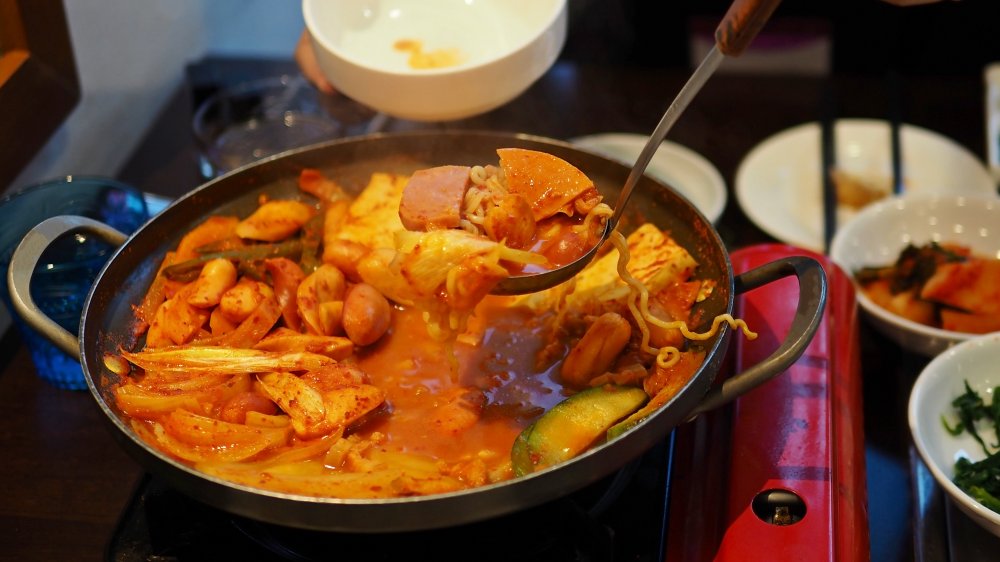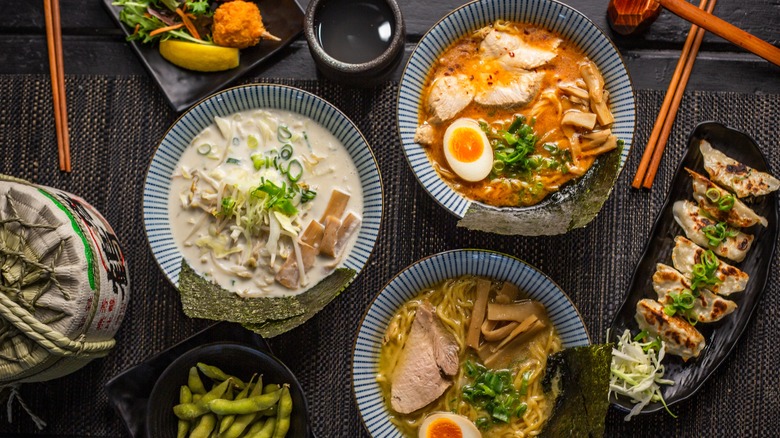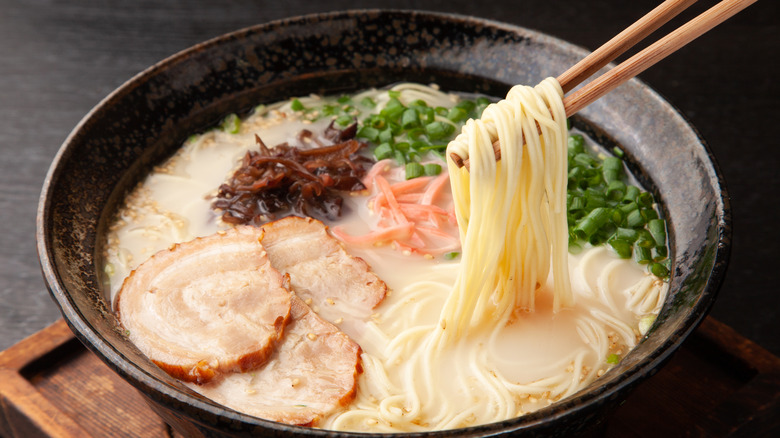Why Is Instant Ramen So Cheap?
They're so iconic they have an entire museum dedicated to them. They were the first noodles to be consumed in outer space. And while they began as a luxury item, instant ramen today costs 13 cents per packet (based on 2018 prices), and according to The Daily Californian, if you ate ramen three times a day for 365 days, you'd be looking to live on less than $145 for that year.
Instant ramen is easy on our pockets because it is cheap to produce. Healthline says the noodles are made from wheat flour, which has been fortified with synthetic forms of vitamin B and iron. After they are made, the noodles are steamed, dunked in chicken broth, then fried, in a process designed to give the product longer shelf lives.
Making them ready-to-eat is easy — all you need to do is rehydrate the noodles and toss in a soup packet made primarily with MSG, salt, sugar, and flavorings to round out the eating experience, via NPR. World Instant Noodles Association says instant ramen today is enjoyed with a variety of spices found in local food cultures including garlic, ginger, and lemongrass (Southeast Asia and China); curry (South Asia); chili pepper (Korea); soy sauce (Japan); cheese (Europe and the Americas); bean paste (East Asia); and citrus (Mexico and the Philippines).
Instant ramen was invented to fill hungry stomachs
Even if instant ramen is not exactly nutritious, it will continue to be widely consumed because as anthropologists like Sidney Mintz say, it is a "proletariat hunger killer" as the noodle's low price points allow everyone to eat. They are prepared with soup, which makes a consumer feel full for longer; they are made with wheat flour, which has a high glycemic index; and before they are dehydrated, the noodles are fried in palm oil, which NutriStrategy says has the second-highest concentration of saturated fat (81 ) among all vegetable oils. And like soup, the oil can make the noodles more filling.
But just as there is a hidden health cost associated with living on an instant ramen diet, there is also a hidden environmental cost. Palm oil, which is used to produce instant ramen, cannot be replaced easily as an ingredient because it is a natural preservative, and because it is the world's most inexpensive, versatile, and sought after vegetable oil (which is one of the biggest reasons ramen noodles themselves are so cheap).
Palm oil, though, is also one of the leading causes of deforestation in Malaysia and Indonesia, via The Guardian. And thanks to the large hidden cost of instant ramen to your health and the environment, instant ramen doesn't seem worth the 13 cents a packet anymore, especially for those who can afford to make that choice.
Many families rely on instant ramen
For struggling families, instant ramen has become a weekly menu staple. According to Insider, more than 100 billion packs of instant ramen are consumed each year. Momofuku Ando invented instant ramen in 1958 to curve the issue of hunger in Japan, and since then, the easy-to-make noodle packs have continued to accomplish that goal. As reported by Gizmodo, Ando sought to create a product that was tasty, safe, nonperishable, economical, and ready in three minutes or less. These factors make instant noodles an easy choice for starving children and college students alike.
American isn't the only place where these noodles have been helpful. According to Statista, the top noodle consuming country is South Korea, followed by Nepal, Indonesia, Japan, and China. The United States doesn't appear on that list until eight, with the United Kingdom, India, France, and Argentina coming in behind. In the top country, South Korea, more than 75 servings are believed to be consumed per person per year.
The difference between instant ramen and traditional ramen
Traditional Japanese ramen noodles differ quite a bit from the store bought variety you're used to. Per The Japanese Way, ramen is made with a different type of wheat flour than instant noodles, giving it a chewier texture. Traditional ramen is also always served in broth, while instant ramen comes dry out of a pack.
Though instant noodles seem like the easier choice when you're in need of a quick meal, real ramen can be frozen, which helps the flavors blend together and decreases its starchiness. Additionally, traditional ramen noodles aren't fried and are usually served with pork and chicken stock as well as scallions.
You also won't find the same price tag on real ramen. According to Love for Traveling, a bowl of ramen in Tokyo costs 600 to 1,200 yen, which is equal to $4.28 to $8.56 USD. Similar to in the United States, buying the ingredients from a grocery store and cooking at home is more affordable than enjoying ramen at a luxurious restaurant, where prices can rise as high as $22.27 for a bowl.



